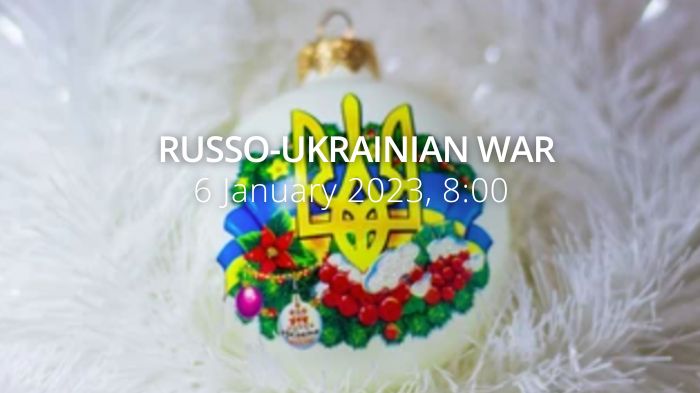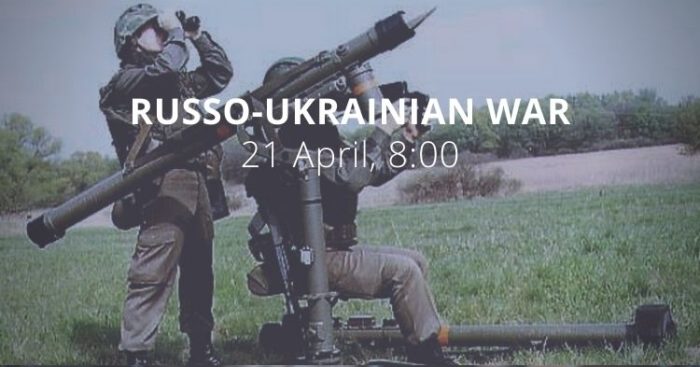Ukrainian forces have continued their offensive against Russian forces in Kherson Oblast. Russian occupation regime in Kherson Oblast creates an “election committee” in preparation for a “referendum.” In Donbas, Russians are making minimal progress. Ukrainian Zelensky says the strike on Odesa port showed Moscow could not be trusted to implement the grain export deal. Ukraine urges the UN and Türkiye to force Russia to comply with grain export agreements. The UK to send scores of artillery guns and hundreds of drones to Ukraine. Environmental damage caused by the Russian invasion is estimated at UAH204 billion. UN receives over 150 reports of rape committed by Russian troops in Ukraine.
Daily overview — Summary report, July 24
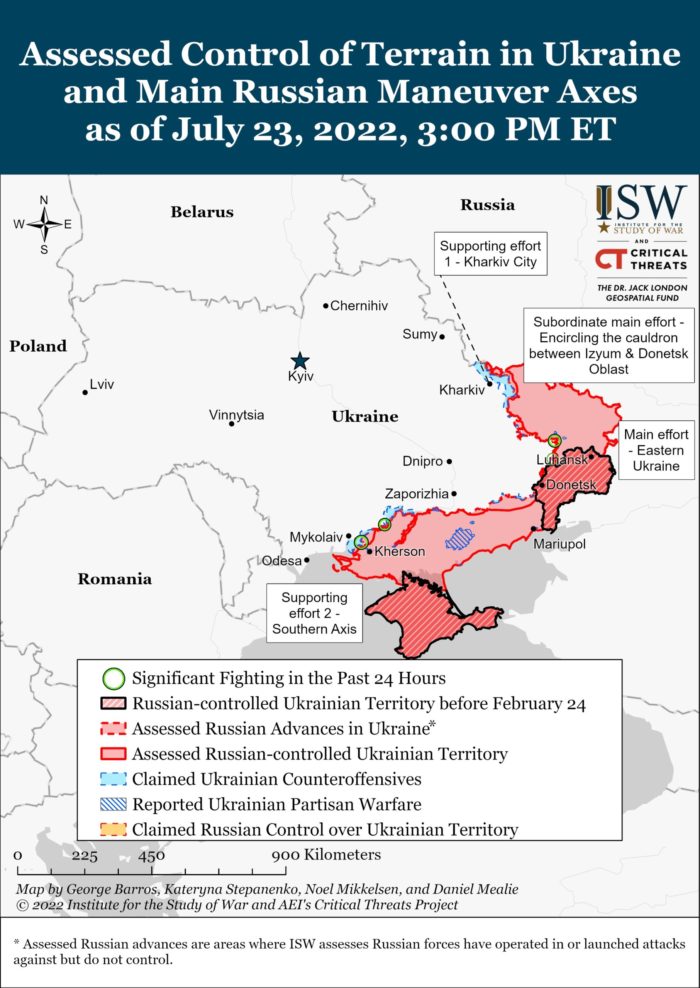
According to military expert Stanislav Haider, as of July 24,
"The best update that hit the news only yesterday evening is that the US intends to supply 25-30 HIMARS units to Ukraine," Haider says.
Donetsk and Luhansk oblasts. A month into their attempts to do it, the Russians again infiltrated the territory of the Vuglehirsk power plant, though the Armed Forces of Ukraine knew what to do and pushed the Russians back again. The Russian troops also sustained losses during an attempted assault near Verkhnokamianske. Heavy fighting continues near Hryhorivka east of Siversk. Ukrainian troops control Bilohorivka (Luhansk oblast).
In the directions of Avdiivka, Bohorodychne, Hryhorivka, and Novoluhanske, fighting continues with Russians not achieving any successes. Russia's attempt to regain their lost positions near Vuhledar failed as well. Near Dolyna, a Russian reconnaissance group tried to scout the Ukrainian defenses for weak points.
Kharkiv Oblast. The Russian offensive has practically dwindled to nothing, which didn't stop them from shelling the cities. Thanks to the actions of the Ukrainian forces, the full-scale Russian attack on Sloviansk never started. There are no changes in the Balaklia and Pechenihy directions.
Kherson Oblast. Yesterday, the Ukrainian artillery continued attacks on Russian-controlled bridges behind the front lines - the one in Daryivka came under Ukrainian fire. Firther attacks on the bridges in Antonivka and Daryivka may cut off the entire Russian grouping of forces around Kherson of Russian supply lines.
The north-western sector of the region's front saw some successes in Ukraine's attacks on Russian strongholds.
To the west of Kherson, settlements are changing hands -Oleksandrivka is now under the Russian control again. The Russians tried to advance from the direction of Davydiv Brid towards Bilohirka, but the fierce Ukrainian resistance forced them to retreat.
Zaporizhzhia oblast. The Ukrainian troops slightly improved the situation in the direction of Vasylivka. Other directions see artillery duels with Ukrainian counter-artillery fire "looking much more effective than Russia's."
Something blew up at the Melitopol airfield, which the occupiers are unsuccessfully trying to restore after the Ukrainian attacks. Also the railway was damaged, which Russia uses to transport military equipment and personnel in the direction of Vasylivka and Tokmak adding to Russian logistics issues.
Ukrainian troops damaged another bridge near Kherson, across Inhulets river.
Together with an already closed bridge across Dnipro, this would cut Russian troops around Kherson from supplies. Yet, it's unclear whether the current damage is already enough https://t.co/D1JNfHMGQS pic.twitter.com/BHhtTzUa6k
— Euromaidan Press (@EuromaidanPress) July 23, 2022
The work of Ukrainian artillery. Tavriysk, Kherson Oblast saw a surgical strike on Russian positions. The "HQ of the 6th Regiment, 2nd Army Corps" was eliminated in Lysychansk, Luhansk Oblast.
Headquarters of the 6th regiment of the second Russian army corps was eliminated in Ukraine's Luhansk Oblast.
Oblast Head Haidai said that "a clap" as Russians say occurred in currently occupied Lysychansk in the court building, killing up to 50 invaders https://t.co/CTOVKNyQu5
— Euromaidan Press (@EuromaidanPress) July 23, 2022
In Kadiivka (formerly Stakhanov) the Armed Forces hit a train loaded with ammo, equipment, and manpower. In Donetsk Oblast, the Ukrainian artillery also worked out at ammunition warehouses in Makiivka, and on the major ammo depot in Horlivka.
A powerful explosion occurred today in the Russian-occupied Horlivka, Donetsk Oblast
As "Novosti Donbasa" reports, the explosion occurred on the territory of the Mashzavod after shelling pic.twitter.com/2ttphj23Ep
— Euromaidan Press (@EuromaidanPress) July 23, 2022
A map of the approximate situation on the ground in Ukraine as of 00:00 UTC 24/07/22. pic.twitter.com/XdJX8jCLju
— War Mapper (@War_Mapper) July 24, 2022
The General Staff’s operational update regarding the Russian invasion as of 06.00 am, July 24, 2022 is in the dropdown menu below.
According to information from the General Staff as of 06.00 24.07.2022, supplemented by its [18:00 assessment].
“The situation has not undergone any significant changes in the Volyn and Polissya directions. The units of the armed forces of the Republic of Belarus continue to carry out certain tasks to strengthen security in the border areas of the Brest and Gomel regions.
In the Siversky direction, Russian forces shelled the areas of the settlements of Hai in the Chernihiv oblast and Hudove, Yastrubyne, Bilopillia and Hrabovske in the Sumy Oblast. In addition, it periodically conducts aerial reconnaissance of the positions of the defence forces in the border areas of Chernihiv and Sumy oblasts. [Yesterday. Russian forces shelled the village of Starykov, Sumy oblast. Aerial reconnaissance of the border area in Chernihiv and Sumy oblasts by unmanned aerial vehicles continues.]
[In the Slobozhansk direction, Russian forces', using all available means, continue to restrain the units of the Defense Forces from advancing deep into the temporarily occupied territory.]
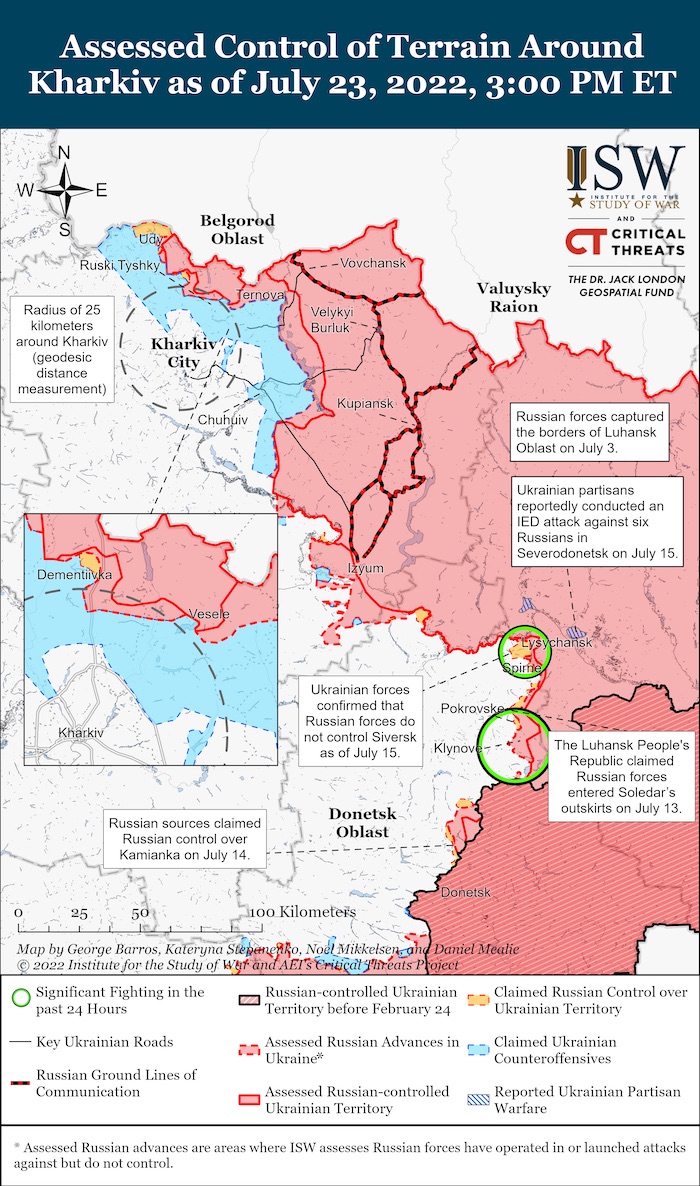
- In the Kharkiv direction, Russian forces carried out fire damage from artillery and MLRS in the areas of Pytomnyk, Petrivka, Novomykolaivka, Stary Saltiv, Blahodatne, Prudyanka, Lisne, Lebyazhe, Korobochkyne, Derhachi, Peremoha and other settlements. [Yesterday, Russian forces carried out fire damage from artillery and MLRS in the areas of the settlements of Kharkiv, Ruski Tyshki, Cherkaski Tyshki, Bazaliivka, Husarivka, Ruska Lozova, Udy, Malynivka and of others. Made an airstrike near Verkhniy Saltiv.]
- In the Sloviansk direction, Russian forces shelled with artillery, in particular, the areas of Chepil, Bohorodychne, and Adamivka. [Yesterday, Russian forces fired artillery at the districts of Dibrovne, Velyka Komyshuvakha, Nova Dmytryvka, and others. They tried to identify weak points in the defence of our troops near Bohorodychne. The Russian reconnaissance group was neutralized.]
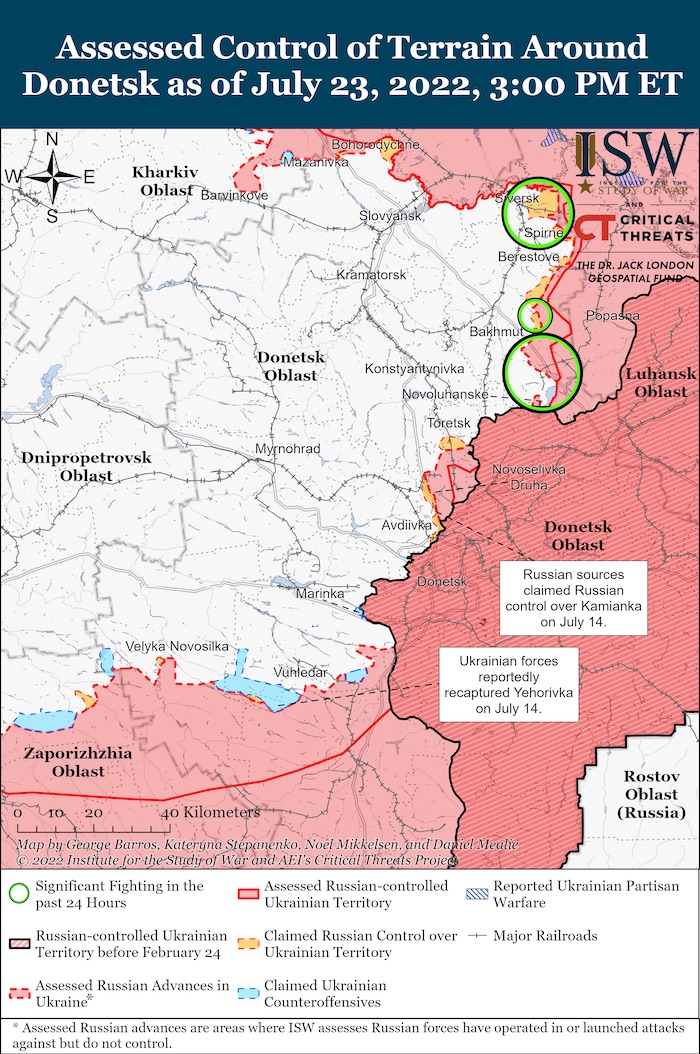
[In the Donetsk direction, the occupiers continue to focus their main efforts on the Kramatorsk and Bakhmut directions, and attempts to establish control over the territory of the Vugleghirskaya TPP continue.]
- In the Kramatorsk direction, shelling was recorded near Starodubivka, Dronivka, Piskunivka, Siversk, Spirne and Ivano-Daryivka. The occupiers also used the UAV system. [Yesterday, Russian forces shelled, in particular, the areas of Verkhnokamianske, Riznyivka, Zakitne, Hryhorivka, Vyimka and Zvanivka settlements. Made an airstrike near Spirny.]
- [He tried to improve the tactical position in the Verkhnokamyansky area by attacking from different directions. Ukrainian soldiers met Russian forces with accurate fire and inflicted significant losses. The occupiers retreated in panic.]
- In the Bakhmut direction, Russian forces are conducting combat operations to create conditions for an offensive on Bakhmut and take over the territory of the Vuhleghirska TPP. He carried out shelling of military and civilian infrastructure in the areas of Zaitseve, Vershyna, Berestove, Shumy, Bakhmut, New York, Bakhmutske, Pokrovske, Novoluhanske, Vesele and other settlements. Used attack and army aviation. [Yesterday, Russian forces were trying to create favourable conditions for continuing the offensive on Bakhmut. It fired at our troops from tanks, artillery, and MLRS in the areas of Travnevo, Semihirya, Rozdolivka, Yakovlivka, Soledar, Bilohorivka, and many other settlements. Airstrikes on Pokrovske and Novoluhanske.]
- From different directions, Russian forces carried out assaults to establish control over the territory of the Vuhlehirska TPP. Ukrainian soldiers repulsed the invaders again.
- [Enemy reconnaissance groups tried to identify weak points in the defence of our troops in the directions of Soledar and Pokrovske. Detected and neutralized.]
- On the Avdiivka, Novopavlivka, and Zaporizhzhia directions, systematic shelling was recorded in the areas of the settlements of Zolota Nyva, Vuhledar, Vesele, Avdiivka, Krasnohorivka, and many others. Enemy UAV operated near Malaya Tokmachka and Novodarivka. In some areas, the occupiers are trying to improve the engineering equipment of defensive lines and positions. [Yesterday, Russian forces systematically shelled civilian and military infrastructure in the areas of the settlements of Novobakhmutivka, Pisky, Opytne, Vodyane, Shevchenko, Mala Tokmachka, Novosilka, Zelene Pole, Bilohirya, and many others. There were airstrikes near Krasnohorivka and Kamianka.]
In the Pivdenny Buh directions, Russian forces are concentrating their main efforts on maintaining the occupied positions. Shelled civilian and military infrastructure near Chervona Dolyna, Kyselivka, Ternivka, Dobryanka, Oleksandrivka, Kobzartsi, Lepetykha and others. [Supports a high intensity of reconnaissance by unmanned aerial vehicles. Reciprocal shelling from artillery, MLRS and tanks continue along the entire contact line.]
Our rocket artillery and aviation units continue to hit Russian forces' strongholds, concentration points and warehouses in the designated directions.
[Cases of desertion and open disobedience to the command are increasingly recorded in units of the Russian occupation forces.]”
Military Updates
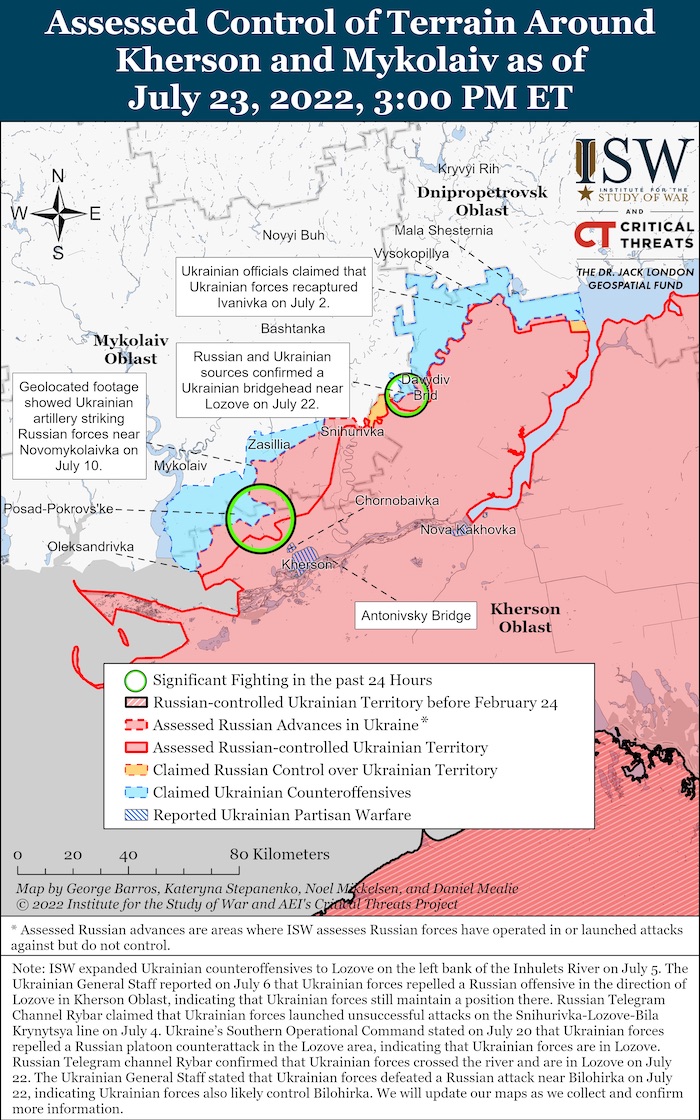
About 2,000 occupants are surrounded in the Kherson direction, UNIAN reported Friday evening, citing The Insider. “[According to sources in the Armed Forces of Ukraine,] three Russian battalion tactical groups, including a special forces company and a tank company, requested a "green corridor" to get out of the encirclement.
It should be noted that this agrees with the information from the military expert Oleksandr Kovalenko, who earlier [Friday] said that near the village of Vysokopolye in the Kherson region, Russian invaders fell into a cauldron and demanded to organize a "green corridor" to get out of the encirclement of Ukrainian defenders.
According to The Insider, the offensive of the Armed Forces of Ukraine was carried out in two directions at once: Olgino - Kostyrka and Potemkino - Novovoznesenskoye.”
More than 5,000 Ukrainian women defending the country on the front lines, Ukrinform reports. "In addition to 38,000 military servicewomen, we also have civilian women employed by the Armed Forces of Ukraine. Therefore, in total, we have more than 50,000 women as part of the Armed Forces. Today, we have more than 5,000 women on the front lines, [Deputy Minister of Defense Hanna] Maliar said. Taking these numbers into account, the deputy minister noted, Ukraine today has one of the highest shares of women in the Army, compared to NATO member states.”
According to British Defence Intelligence, (last 48 hours):
- In the Donbas, small-scale Russian offensive action remains focused on the Bakhmut axis, but it is making minimal progress.
- On 20 July 2022, Russian foreign minister Sergei Lavrov said that Russia had expanded the scope of its ‘special military operation’ beyond the self-declared Luhansk and Donetsk People’s Republics. Lavrov claimed that the operation now included new additional areas, including the Ukrainian regions of Kherson and Zaporizhzhia, as a result of Western countries supplying longer-range weapons to Ukraine. This is almost certainly not true. Russia has not ‘expanded’ its war; maintaining long-term control of these areas was almost certainly an original goal of the invasion. Russia invaded these areas in February and the occupation authorities have been publicly discussing the prospects for legal independent referendums since at least mid-March.
- There is a realistic possibility that Lavrov made the comments to pave the way for referenda to take place in occupied territories beyond Luhansk and Donetsk.
- In the last 48 hours, heavy fighting has been taking place as Ukrainian forces have continued their offensive against Russian forces in Kherson Oblast, west of the River Dnipro. Russia is likely attempting to slow the Ukrainian attack using artillery fire along the natural barrier of the Ingulets River, a tributary of the Dnipro.
- Simultaneously, the supply lines of the Russian force west of the Dnipro are increasingly at risk. Additional Ukrainian strikes have caused further damage to the key Antonivsky Bridge, though Russia has conducted temporary repairs. As of 22 July 2022, it was almost certainly open to some traffic.
- It has not been possible to verify claims by Ukrainian officials that Russia is preparing to construct an alternative, military pontoon bridge across the Dnipro. The Russian army prioritises maintaining its military bridging capability, but any attempt to construct a crossing of the Dnipro would be a very high-risk operation. If the Dnipro crossings were denied, and Russian forces in occupied Kherson cut off, it would be a significant military and political setback for Russia.
Losses of the Russian army
As of 24 July, the approximate losses of weapons and military equipment of the Russian Armed Forces from the beginning of the war to the present day:
- Personnel – more than 39520 (+280),
- Tanks – 1722 (+14),
- Armoured combat vehicles – 3942 (+13),
- Artillery systems – 869 (+5),
- Multiple rocket launchers –MLRS - 255 (+2),
- Air defence means – 113 (+0),
- Aircraft - 221 (+0),
- Helicopters - 188 (+0),
- Automotive technology and fuel tanks – 2823 (+3),
- Vessels/boats - 15 (+0),
- UAV operational and tactical level – 714 (+0),
- Special equipment – 73 (+1),
- Mobile SRBM system – 4 (+0),
- Cruise missiles – 170 (+3)
Russian enemy suffered the greatest losses (of the last day) in the Kramatorsk direction.
⚰️russia's combat losses in Ukraine as of July 24
▪ 39520 killed soldiers (+280)
▪ 3942 APV (+13)
▪ 1722 tanks (+14)
▪ 869 artillery systems (+5)
▪ 221 aircraft and 188 helicopters
▪ 15 boats and cutters #StopRussia #StandWithUkraine pic.twitter.com/eFmI6gJTcH— VoxUkraine (@voxukraine) July 24, 2022
The US estimates roughly 15,000 Russian forces have been killed, The Washington Post reports. “CIA Director William Burns on Wednesday said the US estimates roughly 15,000 Russian forces have been killed. That death toll would be equivalent to the Soviet Union’s military losses in its 1980s war in Afghanistan, which lasted nearly a decade.”
Hans Petter Midttun: The differences in US and Ukrainian assessments of Russian casualties is due to methodology. US Intelligence reports verified numbers only, which means that their numbers represent the minimum of KIA (conservative). The actual numbers are always higher. Ukrainian figures are most likely built on combat reports difficult to verify, but still, the best estimate of the tactical commanders at the frontline (positive).
Humanitarian
https://twitter.com/EuromaidanPress/status/1551077702706335746
The war in Ukraine continued to shatter the lives of millions of people across the country. Damages to civilian infrastructure are alarmingly impacting people’s access to essential services, particularly water, electricity and health services in the Donbas region. Humanitarians have reached more people than initially targeted, yet far from covering the needs of 16 million Ukrainians who require humanitarian assistance.
The war has continued to take a heavy toll on civilians. On 19 July, the Governor of Luhanska oblast – which is currently almost entirely beyond Government control – said it is difficult to know how many people had died in the east of the oblast and how many residents remained. He said the intensity of the shelling in recent months often made it impossible for people to recover the bodies of family members – and that there were cases of residents being killed when trying to do so. Also, on 19 July, the governor of Donetsk oblast said that more than 600 civilians had been killed in the oblast, and over 1,600 had been injured. However, he added it is still impossible to have an accurate idea of the number of civilians killed and injured in the cities of Mariupol and Volnovakha, both previously inaccessible because of the fighting and currently beyond the control of the Government.
The total number of verified civilian casualties of the war is now approaching 12,000. The UN Human Rights Monitoring Mission in Ukraine (HRMMU) has corroborated, as of 17 July, 11,862 civilian casualties since 24 February – 5,110 killed (including 1,943 men, 1,342 women, 163 boys and 142 girls) and 6,752 injured (including 1,359 men, 1,001 women, 210 boys and 147 girls). More than half of the casualties (6,687) were recorded and corroborated in eastern Donetska and Luhanska oblasts. HRMMU believes the real totals are considerably higher, as the receipt of information from some locations has been delayed, and many reports are still pending confirmation.
️️Environmental
What do we know about the “mirror agreement” signed by Russia and Ukraine to allow exports of grain through the Black Sea? Both sides attended the signing ceremony in Istanbul but did not sit at the same table. Kyiv refused to sign a direct deal with Moscow. The following details of the deal are known from reporting by BBC, Ukrainian Pravda, NPR, Aljazeera, The Maritime Executive and The Washington Post.
- Duration
- The deal is set to last for 120 days. It can be renewed if both parties agree.
- Aim
- The deal aims to help avert famine by injecting more wheat, sunflower oil, fertiliser and other products into world markets, including for humanitarian needs. It targets the pre-war level of five million metric tonnes of grain exported each month. The UN World Food Programme says some 47 million peopleare now in a stage of “acute hunger” due to fallout from the war and experts have long warned of a looming global food crisis if Ukrainian grain exports remained blocked.
- Scope
- Russia has agreed to not undertake any attacks against merchant vessels and other civilian vessels and port facilities (a “de facto ceasefire” for the ships and facilities covered).
- No vesselsother than those intended to export grain and related food products and fertilisers are allowed to enter.
- The agreement does not provide for any weakening of sanctions against Russia
- A parallel agreement is supposed to facilitate Russian grain and fertilizer exports.
- Coordination
- A Joint Control Center (JCC) will schedule and monitor shipments.
- The JCC will be established in Istanbul and staffed by UN, Turkish, Russian and Ukrainian officials.
- Control
- Ships bound for Ukraine will be inspected at a Turkish port by the JCC staff to ensure they are not carrying weapons.
- A Turkish, Ukrainian and UN staff will monitor the loading of grain in Ukrainian ports
- In transit
- The deal makes provisions for the safe passage of ships.
- The ships will follow a prescribed route out of Ukrainian waters and transit the Bosphorus to a Turkish port where they will be inspected before heading into the world markets.
- There would be no military escorts of the ships, whose passage will be monitored from the JCC in Istanbul.
- A Ukrainian vessel will guide cargo vessels through Ukrainian defensive minefields along the coastline (“Mine Lead-Through”).
- Ukrainian ports
- The agreement opens for commercial food exports from three key Ukrainian ports – Odesa, Chernomorsk and Yuzhny.
- UN and Turkish monitors will be present in Ukrainian ports to demarcate areas protected by the agreement.
- Control over the seaports of Odesa, Chornomorsk and Pivdennyi (Yuzhnye) remains entirely with the Ukrainian side. No presence of Russian representatives is allowed.
The validity of the agreement will be tested in real-time. Firstly, the response of the shipping market will demonstrate if the parties achieved the primary aim of the agreement. According to the media, insurance underwriters and shipping companies sees the plan as viable. Several insurance underwriters are interested in providing cover for the grain shipments from Ukraine, industry sources said on Friday. Still, it remains to be seen if maritime insurance allows commercial ships to enter the ports in light of the risks of collateral damage?
Will the International Maritime Organisation and NATO change their risk assessments and advice to mariners? As of 1 July, the NATO assessment is as follows: Drifting mines have been detected. The threat of collateral damage or direct hits on civilian shipping in the War Risk Area of the Black Sea area remains HIGH. The threat of GPS jamming, AIS spoofing, communications jamming, electronic interference and cyber-attacks in the area are also considered HIGH. Harassment and diversion of shipping in the area cannot be excluded.
Analysts at S&P Global Market Intelligence cautioned that even though the agreement has been reached, it could take a few weeks to months to resolve concerns for the Black Sea routes to resume, The Maritime Executive reports. “Danube River ports will likely remain a safe and attractive option for grain exports in the near term, said Daejin Lee, Lead Shipping Analyst at S&P Global Market Intelligence. In the early stage, Lee predicts that small domestic vessels will operate at increasing capacity but the efficient shipment of grain out of Ukraine requires larger bulk carriers which will likely not return until insurance and safety issues are resolved.”
Secondly, will Russia – in the spirit of the agreement - cease all attacks on Ukrainian ports to ensure the safety of the ships? Any attack includes the risk of collateral damage to port facilities, ships and storage of agricultural products. This question was partly answered on 23 July already when Russia attacked Odesa with four cruise missiles, highlighting all of the abovementioned concerns and undermining trust within the maritime industry.
During today's missile strike at Odesa port, the blast wave damaged the building of Art Museum.
Ukraine's Culture Minister stressed that the port is located close to key objects of Odessa's cultural heritage, included in Preliminary List of UNESCO https://t.co/ymgmRnqqDl pic.twitter.com/cHBIfaMIwZ
— Euromaidan Press (@EuromaidanPress) July 23, 2022
Russian missiles strike Odesa port day after grain deal, The Washington Post reports. “Russian missiles hit the Black Sea port of Odesa on Saturday, Ukrainian officials said a day after Moscow and Kyiv reached a deal to release millions of tons of trapped grain and ease a global food crisis.
The military command in southern Ukraine said two Kalibr cruise missiles “hit the infrastructure of the port” in the city of Odesa — one of the country’s largest and most important seaside trading hubs. The military said air defence systems shot down two other missiles. The strike imperils an agreement that UN and Turkish officials, less than 24 hours earlier, had hailed as a breakthrough after months of negotiations. Friday’s agreement, brokered by the United Nations and Türkiye, would help lift a blockade that has exposed countries around the world to the threat of rising hunger, especially in Africa and the Middle East.”
Ukrainian President Volodymyr Zelensky said the strike showed Moscow could not be trusted to implement the deal, Reuters reports. “However, public broadcaster Suspilne quoted the Ukrainian military as saying the missiles had not caused significant damage and a government minister said preparations continued to restart grain exports from the country's Black Sea ports.”
Environmental damage caused by the Russian invasion is estimated at UAH204 billion, Ukrinform reports, citing the press service of the Ministry of Environmental Protection and Natural Resources of Ukraine. "The team has developed 10 new methods for calculating the damage caused to the environment. Already, the amount of damages from Russian aggression has reached UAH 204 billion [5,57 Bln USD]. These developments are of global significance. Russia is the main eco-terrorist today, the message reads.
It is specified that experts continue to document crimes committed by Russians against Ukrainian ecology. Since the full-scale invasion, more than 2,000 such cases have been recorded. The government is now preparing lawsuits to file with international courts.”
Legal
The West needs a new strategy: Russia will never be democratized – social scientist
UN receives over 150 reports of rape committed by Russian troops in Ukraine – envoy, Ukrinform reports. “Since February 24, the UN has received more than 150 reports regarding cases of sexual violence committed by the Russian military in Ukraine, and this is only the "extreme tip of the iceberg." This was stated by the Special Representative of the UN Secretary-General on Sexual Violence in Conflict, Pramila Patten”.
Threats and abductions to force #Melitopol residents to take part in fake ‘referendum on joining #Russia’ #Zaporizhzhia #Ukraine #StandWithUkraine #RussiaWarCrimes #StopRussia https://t.co/qhnzjn7VGo pic.twitter.com/0MWJao8lb0
— Halya Coynash (@halyapuff) July 24, 2022
Russian occupation regime in Kherson Oblast creates an “election committee” in preparation for a “referendum”
, Ukrainska Pravda reports, citing TASS and Meduza. “The Kherson Oblast occupation administration reported that an "election committee" was created to organise a "referendum on joining the Russian Federation." The so-called "election committee" will include seven people.
https://twitter.com/EuromaidanPress/status/1550931756081086464
The media reports that the occupation administration is intending to hold the "referendums" [in Zaporizhzhia and Kherson oblasts - ed.] on 11 September 2022. Earlier on 23 July, the Russian occupation administration in Zaporizhzhia Oblast created an "election committee" to hold a so-called "referendum" [on joining the Russian Federation - ed.].”
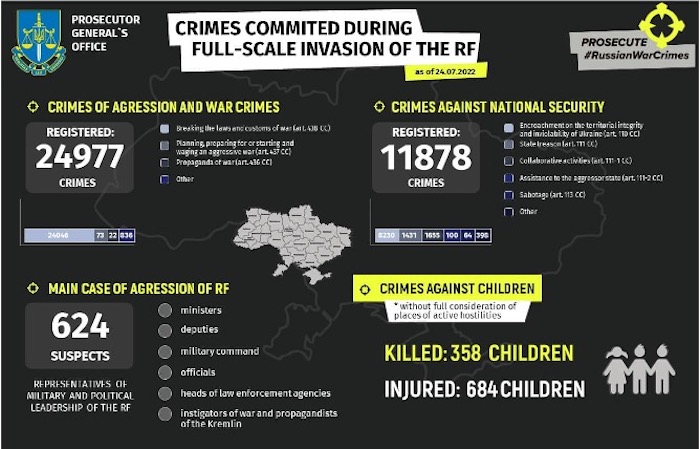
358 children were killed, and 684 children injured, the Office of the Prosecutor General of Ukraine reports as of July 24. 2,188 educational establishments are damaged as a result of shelling and bombings, 221 of them are destroyed fully. 24,977 crimes of aggression and war crimes and 11,878 crimes against national security were registered.
https://twitter.com/EuromaidanPress/status/1550942577750429697
Support
The UK to send scores of artillery guns and hundreds of drones to Ukraine, the UK Government said in a press release. “Ben Wallace reveals the latest British military support for Ukraine, including plans to send 50,000 artillery shells and hundreds more anti-tank weapons in the coming weeks. The delivery of the new equipment will significantly step up the UK’s support as the country fights to repel Russia’s brutal and unjustified invasion.
More than 20 M109 155mm self-propelled guns and 36 L119 105mm artillery guns will soon arrive from the UK, Defence Secretary Ben Wallace announced in an update to Parliament today. Counter-battery radar systems and more than 50,000 rounds of ammunition for Ukraine’s existing Soviet-era artillery will also follow, he added.
The UK will also send more than 1,600 more anti-tank weapons in the coming weeks, along with drones, including hundreds of loitering aerial munitions.”
White House announces $270M military package for Ukraine, The Washington Post reports. “The White House announced Friday that the US is sending an additional $270 million in security assistance to Ukraine, a package that will include additional medium-range rocket systems and tactical drones.
The new package includes four High Mobility Artillery Rocket Systems, or HIMARS and will allow Kyiv to acquire up to 580 Phoenix Ghost drones, both crucial weapon systems that have allowed the Ukrainians to stay in the fight despite Russian artillery supremacy, according to John Kirby, the White House National Security Council’s coordinator for strategic communications. The latest assistance also includes some 36,000 rounds of artillery ammunition and additional ammunition for the HIMARS.”
Senior US lawmaker states goal to send Ukraine up to 30 HIMARS, other MLR systems, Ukrinform reports, citing RFE/RL. “Chairman of the Armed Service Committee of the US House of Representatives, Adam Smith, expressed doubt that the US has exactly 50 HIMARS units in its arsenal, while the goal is to deliver to Ukraine 25 to 30 multiple rocket launchers, which would be a combination of HIMARS and several MLR systems from Great Britain and other countries.
The legislator added that the US also intends to provide as much munitions to these systems as possible. As reported, Ukrainian Defense Minister Oleksii Reznikov said that Ukraine needs at least 50 HIMARS and M270 systems to effectively deter Russian forces, and at least 100 to run an effective counteroffensive.”
Ukraine says the air force needs western fighter jets, and the US is preparing to help, Defense News reports. “The US Air Force is working to decide how best to train Ukraine’s pilots as the embattled nation’s air force looks to modernize.
In comments at the Aspen Security Forum in Colorado on Wednesday, Air Force Secretary Frank Kendall and Chief of Staff Gen. CQ Brown said Ukraine will need to shift its air force away from legacy Russian MiG and Sukhoi fighters and toward more modern Western-made aircraft. With the supply of Russian spare parts for MiGs cut off, Brown said, Ukraine will have to eventually move to other fighters.
It remains to be seen which platforms make sense, he said, but there are many possibilities — not just US-made fighters such as the F-15 and F-16, but the Eurofighter, Swedish Gripen and French Rafale could also be options for Ukraine’s air force. Part of this is understanding where Ukraine wants to go, and how we meet them where they are, Brown said. All of our allies and partners have an interest in ensuring Ukraine can provide for its own security.”
The US weighs jets for Ukraine but not near-term, White House says, Reuters reports. “The US Department of Defense is considering whether it can send fighter jets to Ukraine in the future, a White House spokesman told reporters on Friday as the conflict with Russia enters its fifth month and fighting rages in eastern Ukraine.
While the Biden administration was making preliminary explorations into the feasibility of potentially providing the jets to Ukraine, the move is not something that would be executed in the near term, White House spokesman John Kirby told reporters in a briefing.”
Over 13,000 Starlink terminals operating in Ukraine, Ukrinform reports. "We are trying to provide uninterrupted internet for everyone. There are now more than 13,000 Starlink terminals in Ukraine. First of all, it’s the medical and educational facilities that receive them wherever there’s such need. We are sure that, despite everything that’s happening, we will have the internet available. We hope that we will always remain in touch, said the Deputy Prime Minister, Minister of Digital Transformation Mykhailo Fedorov.
Starlink is a project by SpaceX, which provides access to broadband internet using a network of satellites. The speed is up to 1 Gbit/s for each subscriber, while the access is available on all continents.”
Hans Petter Midttun:
Starlink, a satellite communication system owned by Musk’s SpaceX. The system, based on a cluster of table-sized satellites flying as low as 130 miles above Ukraine and beaming down high-speed internet access, has become a lifeline to the country: both on the battlefield and in the war for public opinion. It both denies Russia control over the information space along the frontline and allows for effective command and control despite increasingly sophisticated attacks from Russian hackers. Just an hour before Russian troops launched their full-scale assault in the early hours of Feb. 24, the Kremlin successfully hacked Viasat, an American satellite provider whose network was used by the Ukrainian military to communicate with front-line troops.
New Developments
- A deal was signed on Friday to allow grain exports to resume by sea, BBC “Ukraine and Russia have signed "mirror" deals which will allow Kyiv to resume exports of grain through the Black Sea. The agreement will [in theory] allow millions of tonnes of grain, currently trapped in Ukraine by the war, to be exported. The world shortage of Ukrainian grain since Russia's 24 February invasion has left millions at risk of hunger. The deal - which took two months to reach - is set to last for 120 days, with a coordination and monitoring center to be established in Istanbul, staffed by UN, Turkish, Russian, and Ukrainian officials. It can be renewed if both parties agree.”
- Ukraine urges the UN and Türkiye to force Russia to comply with grain export agreements, Reuters “Ukraine has called on the United Nations and Türkiye to ensure that Russia fulfills its commitments under the agreement for a safe corridor for grain exports from Ukraine's Black Sea ports, the foreign ministry said on Saturday. Russian missiles hit infrastructure in Ukraine's port of Odesa on Saturday, a day after Russia and Ukraine, with mediation by the United Nations and Türkiye, signed a deal to reopen Black Sea ports to resume such exports.”
- Hungary picked the dark side, European Pravda “The Hungarian Minister of Foreign Affairs, Péter Szijjártó, paid an official visit to Russia on Thursday, breaking the Western diplomatic blockade of the Putin regime. Since February 24, not a single EU top diplomat has visited Moscow. Only one high-level visit happened in April when the world discovered the Russian atrocities in Bucha and other cities. Austrian Chancellor Karl Nehammer went to Putin. But his visit was exceptional - no handshakes, no joint statements. He went to Moscow to warn Putin of the consequences if he did not stop. The Hungarian visit is completely different. His goal is bilateral trade and gas agreements.”
https://twitter.com/EuromaidanPress/status/1550957173617958912
Assessment
- On the war.
The Institute for the Study of War has made the following assessment as of Saturday 23 July:
“Ukrainian forces are likely preparing to launch or have launched a counteroffensive in Kherson Oblast as of July 23, but open-source visibility on the progress and tempo of the counteroffensive will likely be limited and lag behind events. Ukrainian Kherson Oblast Administration Adviser Serhiy Khlan stated on July 23 that Ukrainian forces have seized unspecified settlements in Kherson Oblast but called on Ukrainian civilians to remain silent on the progress of the counteroffensive until Ukrainian authorities release official statements. Foreign Policy National Security Reporter Jack Detsch reported on July 22 that an unspecified senior US defense official stated that Ukrainian forces have recaptured unspecified “portions of Russian-occupied villages” in Kherson over the past week of July 15-22, indicating that Ukrainian forces have made some unspecified territorial advances along frontlines. The area between the front line and Kherson City is rural and primarily composed of small settlements that are less likely to report on force movements and engagements, allowing control-of-terrain in this area to change without evidence appearing in open-source reporting. Russian authorities additionally have no incentive to report on Ukrainian territorial gains. The informational dynamics that allow ISW to report on Russian offensive operations with relatively little lag are thus inverted in this situation. ISW will report on the progress of any Ukrainian counteroffensives to the best of its ability within these constraints.
Head of the Chechen Republic Ramzan Kadyrov seemingly confirmed that Colonel General Sergey Kuzovlev has replaced Army General Aleksandr Dvornikov as acting commander of Russia’s Southern Military District (SMD). Kadyrov stated that Kuzovlev, to whom he explicitly referred as acting commander of the SMD, visited Chechnya on July 23 in order to inspect Kadyrov’s “Akhmat” battalions. Kuzovlev had previously served as chief of staff of the SMD and commanded the Russian grouping in Syria from November 2020 to February 2021. Kuzovlev’s visit and inspection of Kadyrov’s forces, which comes two days after Kadyrov announced that these battalions will not be immediately deploying into Ukraine, may support other hints that Kadyrov is facing mounting domestic pressure. The anti-Kadyrov Sheikh Mansour battalion reportedly announced an insurgency against Kadyrov’s regime on July 21, and Kadyrov may want to hold the newly formed Akhmat battalions in Chechnya to handle any local unrest.
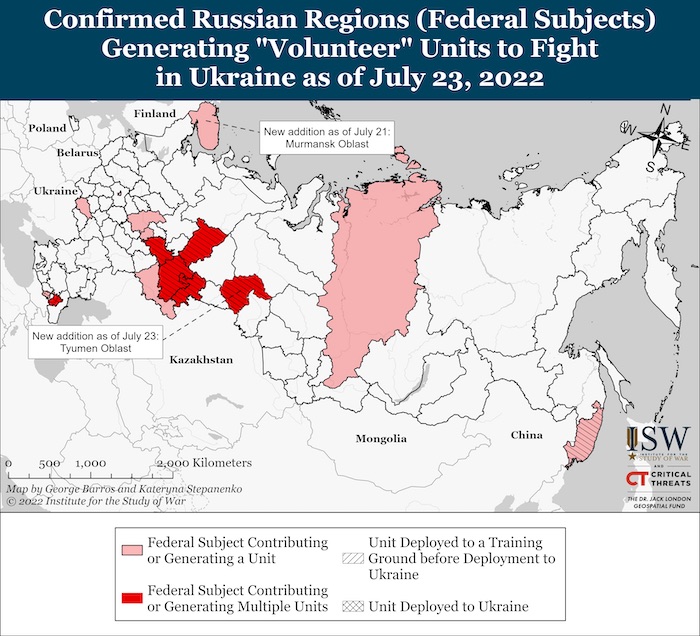
Key Takeaways
- Ukrainian forces are likely preparing to launch, or have already launched, a counteroffensive in Kherson Oblast.
- Head of the Chechen Republic Ramzan Kadyrov indicated that Colonel General Sergey Kuzovlev is the acting commander of the Southern Military District.
- Russian forces conducted limited reconnaissance operations east of Bakhmut and continued limited ground attacks northwest of Sloviansk, east of Siversk, and south of Bakhmut.
- The Kremlin continued to form regional volunteer battalions and likely intends to have 16 such battalions formed by the end of July.
- Russian occupation authorities are continuing to prepare for referenda on the annexation of occupied areas into the Russian Federation and are taking measures to isolate occupied areas from the non-Russian information space.“
After the strikes of the Armed Forces, the occupiers in the Kherson region began importing ammunition under the guise of "humanitarian aid", the Ukrainian General Staff reports, citing the Defence Intelligence of Ukraine (DIU). Russian forces delivers ammunition to the territory of Ukraine under the guise of civilian cargo.
After a series of strikes by the Armed Forces of the Russian Federation on the ammunition warehouses of the “Rucists”, located in the temporarily occupied territories of the Kherson region, the Armed Forces of the Russian Federation started labelling military cargo as "humanitarian aid". More than 20 "civilian" KAMAZ trucks drove to the Kherson region. All of them are painted white with Russian flags and symbols of the political party "United Russia" painted on the cabin doors. The delivered cargo was, however, artillery ammunition and MLRS. New ammunition warehouses are being set up in civilian buildings - cultural and educational institutions.
In general, in connection with the massive fire strikes by the Armed Forces of Ukraine, servicemen of the 1st and 2nd army corps of the Russian Armed Forces are prohibited from moving military equipment during daylight hours during the transportation of personnel and military cargo. In this regard, works are being carried out to convert the existing vehicles to travel in the dark, as well as mask the vehicles. Other divisions of the Russian occupation forces should also carry out similar measures.
The reluctance to fight and participate in the war unleashed by the Kremlin is growing among the soldiers of the aggressor country, the Defence Intelligence of Ukraine (DIU) claims. “The interception of Ukrainian military intelligence indicates panic among the occupiers. However, Russian forces's army does not take into account the opinion of its own soldiers, Andriy Yusov, representative of the Ministry of Defense of Ukraine, said.
The “rucists” don't want to die, they don't want to fight. Even though this activity persists in the east, in the south we see a different picture. The general tone of interceptions from the occupiers is very different from the one at the beginning of the war", - concluded the representative of the DIU.”
Russia wants to form 16 battalions by the end of July and is forming a new corps in the Nizhny Novgorod region, DIU reports. “Russia wants to form 16 battalions by the end of July and is forming a new corps in the Nizhny Novgorod Region" The first thing that concerns these so-called volunteer battalions. This is a new approach that the Russian Federation started very recently.
A month ago, about 50 subjects of the Russian Federation received an order to form battalions numbering 500-600 people. We know that 8 battalions have already been formed as of today. It is planned to form 8 more battalions by the end of the month. There will be such a battalion in every region, including Crimea, Moscow, and St. Petersburg," Vadym Skibitsky said.
In addition, according to the information of DIU, Russia is forming another corps in the Nizhny Novgorod region - this is from 10 to 15 thousand people.
There is also formation, combat coordination, and other issues related to the creation of a new association. And we do not rule out that this corps will be transferred to our territory. The Russian leadership is trying to streamline the process of creating volunteer formations so that they have powerful offensive and defensive capabilities and can act like the battalion tactical groups that were defeated by us. These were big losses for the Russian Federation because they were the most combat-ready and experienced units."
2. Consequences and what to do?
Putin attacks Odesa and a hungry world’s hopes, reads a piece from the Editorial Board of The Washington Post. “Well, that didn’t take long. On Friday, Russia’s defense minister raised a hungry world’s hopes by signing an agreement with the president of Türkiye and the secretary general of the United Nations, according to which Moscow committed to facilitate resumption of large-scale grain shipments from Ukraine’s Black Sea ports. Russia had previously blockaded these, causing stress on global grain markets. Less than 24 hours later, on Saturday, Russian ships launched four long-range missiles at the largest of those ports, Odesa, two of which Ukrainian air defenses intercepted — and two of which caused some structural damage, though no destruction of grain or human casualties. The United States’ ambassador in Kyiv called the attack “outrageous,” which is an understatement.
Saturday’s events were not surprising to those familiar with President Vladimir Putin’s record, in this war and others. He is notorious for violating humanitarian agreements establishing safe “corridors” through which Russian forces and their allies herded Syrian civilians escaping war zones in that country. Often, the fleeing people came under fire or faced violent harassment and arrests. Compliance with the new accord would force Russia to abandon its strategy of denying Ukraine agricultural export earnings, including stealing, and reselling, Ukraine’s stockpiled grain — even, in some areas, burning crops. Depending on where the missiles actually struck, Russia might not have violated the letter of the agreement, under which it reserved the right to strike sections of Ukrainian ports not directly used for grain exports. Still, it clearly violated the spirit.
All of the above helps explain why Ukraine was wise not to deal directly with Moscow, but to sign up for a process that, technically, consists of parallel commitments Ukraine and Russia each made to Türkiye and the United Nations. Ukraine prudently offered only escorts through its maritime minefields, not actual demining, lest it weaken defenses against Russia’s navy.
At the same time, Ukrainian officials were wise to announce after Saturday’s attack that they will continue pursuing the agreement, which would have taken some time to implement in any case. Not only is it still in Ukraine’s economic interest, but one goal of Russia’s attack was likely to provoke a Ukrainian pullout, after which Moscow would blame Kyiv for the consequences. And the downside of a failed deal can be measured by the potential upside of a successful one: Ukraine produced a tenth of the world’s wheat exports during 2021 — with populous countries such as Egypt, Bangladesh, Türkiye, Indonesia and Pakistan, as well as small and economically struggling Lebanon, among the biggest customers. The United Nations World Food Program, which distributes aid to the world’s poor, got 40 percent of its wheat from Ukraine before the war. With even wealthy nations hammered by rising food prices, millions of people around the world could benefit from a flow of 20 million metric tons of Ukrainian grain and other foodstuffs to the world market over the next 120 days.
If Mr. Putin destroys the deal before it gets started — despite the advantages it offers his agricultural exports — he must take the blame. Meanwhile, Türkiye and the United Nations must fulfill their roles as guarantors by holding him accountable, and the United States must send weapons Ukraine needs to protect its ports.”
Ukraine's 80th airborne brigade defeated Russians in Voznesensk, not allowing them to approach Odesa
It destroyed their bridges in iconic Bilohorivka & protected the important settlement of Berestove. Commander Ihor Skybiuk tells details in his interviewhttps://t.co/x0qSbkfsXE
— Euromaidan Press (@EuromaidanPress) July 24, 2022
Hans Petter Midttun:
The agreement on Friday to allow grain exports by ships, the subsequent attack on Odesa port and the Russian denial of any involvement in the attack serves not only as a reminder of the Russian pattern of behaviour but also as yet another demonstration of how trustworthy Russia is. It is not. It never was and it will never be.
Russia has for years acted in blatant violation of international law. Its invasion of Ukraine violates Article 2(4) of the UN Charter. The Law of Armed Conflict is a law that states themselves have negotiated to establish the rules of war. In 1949, these negotiations gave rise to the corpus of the Geneva Convention. Russian actions run contrary to its obligations under the convention. It is abusing human rights and violates international humanitarian law. It has violated all bilateral treaties and agreements with Ukraine, including the Budapest memorandum guaranteeing respect for Ukrainian independence and sovereignty, refraining from the threat or the use of force against Ukraine, and providing assistance to Ukraine if they "should become a victim of an act of aggression".
The Russian Federation has repeatedly demonstrated that it cannot be trusted. It can only be contained through diplomatic and economic isolation, in combination with credible military deterrence.
Trust is, however, the core of the “mirror” agreements signed by Russia, Ukraine, Türkiye and the UN on Friday. Without trust, insurance underwriters and shipping companies will not send sailors and ships into a high-threat area. The Russian attack on Odesa on Saturday did limited damage to the port infrastructure but might potentially, have undermined any confidence the industry might have had in the accord. The next weeks will, therefore, be crucial.
That said, I have mixed feelings about the agreement itself. While I full-heartedly support any initiative that helps fight famine, save lives and alleviate suffering, I cannot refrain from being concerned about its broader impact.
While the agreement has the potential to help save a staggering 47 million people globally from a looming famine, it does not help solve the existential problem for 43 million Ukrainians.
Except for exports of agricultural products, the Russian blockade of Ukrainian imports and exports remains effective. Almost two-thirds of the Ukrainian imports and exports go through its seaports. In 2020 its total merchandise trade was 103,529 million USD, of which 54,337 was imports. While agricultural products represent its biggest export, it only accounts for 41% of the country’s overall exports. Additionally, Russia has established de facto control over Ukraine’s maritime exclusive zones and the huge resources within it. As repeatedly stressed, the continuation of the maritime blockade will undermine the economical viability of Ukraine and might, ultimately lead to its demise.
The agreement also helps undermine the universal Freedom of Navigation as the international community de facto “accept” Russian military dominance over the northern Black Sea. A terrorist state is allowed to set the conditions for international maritime trade in a region serving as a gateway between Asia and Europe. By undermining the rules-based international order, these illegitimate assertions of authority, born out of patent self-interest, are a danger to international peace and security. It reflects yet another violation of international law and the 1982 UN Convention on the Law of the Sea (UNCLOS). Acquiescence to these unlawful, excessive maritime claims can, over time, erode the law and permanently infringe on all nations’ navigational rights and freedoms.
This serves as a reminder of NATO’s inability (or unwillingness) to uphold Freedom of Navigation and respond to the maritime industry's call for protection. This will have global repercussions as present and future sea routes are being contested elsewhere by both Russia and China (e.g. the Northern Sea Route in the Arctic and the South-China Sea). The international community has, unfortunately, lost its foremost guarantor of freedom of navigation and, consequently, maritime trade.



